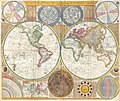Vaizdas:1794 Samuel Dunn Wall Map of the World in Hemispheres - Geographicus - World2-dunn-1794.jpg

Šios peržiūros dydis: 712 × 600 taškų. Kitos 6 rezoliucijos: 285 × 240 taškų | 570 × 480 taškų | 912 × 768 taškų | 1 216 × 1 024 taškų | 2 431 × 2 048 taškų | 6 000 × 5 054 taškų.
Didesnės raiškos iliustracija (6 000 × 5 054 taškų, rinkmenos dydis: 8,92 MiB, MIME tipas: image/jpeg)
Rinkmenos istorija
Paspauskite ant datos/laiko, kad pamatytumėte rinkmeną tokią, kokia ji buvo tuo metu.
| Data/Laikas | Miniatiūra | Matmenys | Naudotojas | Paaiškinimas | |
|---|---|---|---|---|---|
| dabartinis | 23:01, 1 birželio 2012 |  | 6 000 × 5 054 (8,92 MiB) | Brandmeister~commonswiki | Reverted to version as of 04:17, 23 March 2011 |
| 19:15, 19 gegužės 2012 |  | 6 000 × 5 054 (27,38 MiB) | Brandmeister~commonswiki | contrast | |
| 07:17, 23 kovo 2011 |  | 6 000 × 5 054 (8,92 MiB) | BotMultichillT | {{subst:User:Multichill/Geographicus |link=http://www.geographicus.com/P/AntiqueMap/World2-dunn-1794 |product_name=1794 Samuel Dunn Wall Map of the World in Hemispheres |map_title=A General Map of the World, or Terraqueouis Globe with all the New Discover |
Paveikslėlio naudojimas
Paveikslėlis nenaudojamas nei viename straipsnyje.
Visuotinis rinkmenos naudojimas
Ši rinkmena naudojama šiose viki svetainėse:
- Naudojama alt.wikipedia.org
- Naudojama ar.wikipedia.org
- Naudojama av.wikipedia.org
- Naudojama br.wiktionary.org
- Naudojama ckb.wikipedia.org
- Naudojama cv.wikipedia.org
- Naudojama de.wikipedia.org
- Naudojama en.wikipedia.org
- Early world maps
- History of cartography
- Southern Ocean
- Samuel Dunn (mathematician)
- Wikipedia:Featured picture candidates/1794 Samuel Dunn Map
- A General Map of the World, or Terraqueous Globe
- Wikipedia:Featured picture candidates/June-2012
- User:Cruickshanks/sandbox2
- Wikipedia:Featured picture candidates/March-2014
- Wikipedia:Featured picture candidates/1794 Samuel Dunn Wall Map of the World in Hemispheres - Geographicus - World2-dunn-1794.jpg (review)
- User:Setvina/be bold
- Portal:Maps
- User:Sarangem
- User:Jacobwilder427
- Naudojama en.wiktionary.org
- Naudojama eo.wikipedia.org
- Naudojama et.wikipedia.org
- Naudojama eu.wikipedia.org
- Naudojama fa.wikipedia.org
- ویکیپدیا:نگارههای برگزیده/نقشه
- ویکیپدیا:گزیدن نگاره برگزیده/ژوئن-۲۰۱۲
- نقشه ساموئل دان
- ویکیپدیا:گزیدن نگاره برگزیده/1794 Samuel Dunn Wall Map of the World in Hemispheres - Geographicus - World2-dunn-1794.jpg
- ویکیپدیا:نگاره روز/اکتبر ۲۰۱۲
- الگو:نر/2012-10-03
- الگو:نر محافظت شده/2012-10-03
- بحث کاربر:Alborzagros/بایگانی ۷
- Naudojama fr.wikipedia.org
- Naudojama fr.wikiversity.org
- Naudojama gl.wikipedia.org
- Naudojama hu.wikipedia.org
- Naudojama hy.wikipedia.org
Žiūrėti visuotinį šios rinkmenos naudojimą.


